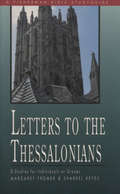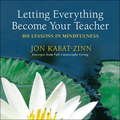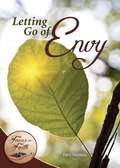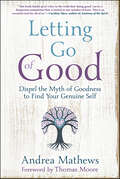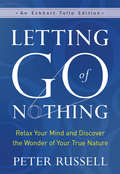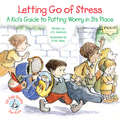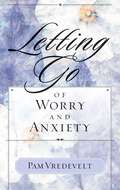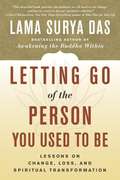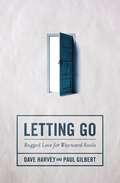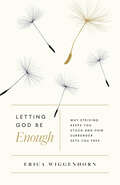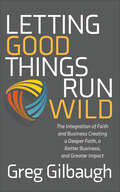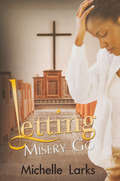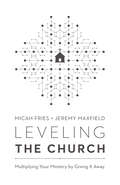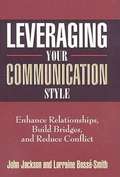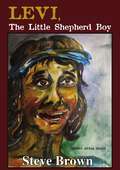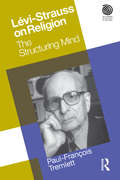- Table View
- List View
Letters to the Thessalonians (Fisherman Bible Studyguide Series)
by Sharrel Keyes Margaret Margaret FromerPaul's letters are full of love, concern, and instruction for His readers--perhaps these letters to the Thessalonians have your name on them as well! From the Trade Paperback edition.
Letting Everything Become Your Teacher
by Jon Kabat-ZinnYes, there actually is a way to let everything become your teacher, to let life itself, and everything that unfolds within it, the "full catastrophe" of the human condition in the words of Zorba the Greek, shape your ongoing development and maturation. Millions have followed this path to greater sanity, balance, and well-being, often in the face of huge stress, pain, uncertainty, sorrow, and illness. In his landmark book, Full Catastrophe Living, Jon Kabat-Zinn shared this innovative approach, known as mindfulness-based stress reduction (MBSR), with the world. Now, in this companion volume, 100 pointers from that groundbreaking work have been carefully selected to inspire you to embrace what is deepest and best and most beautiful in yourself.Whether you are trying to learn patience, cope with pain, deal with the enormous stress and challenges of the age we live in, improve your relationships, or free yourself from destructive emotions, thoughts, and behaviors, these deceptively simple meditations will remind you that you have deep inner resources to draw upon, the most important of which is the present moment itself. Regardless of your age or whether you are familiar with the healing power of mindfulness, this insightful, inspirational guide will help you to honor, embrace, learn from, and grow into each moment of your life.From the Trade Paperback edition.
Letting Everything Become Your Teacher: 100 Lessons in Mindfulness
by Jon Kabat-ZinnYes, there actuallyisa way to let everything become your teacher, to let life itself, and everything that unfolds within it, the “full catastrophe” of the human condition in the words of Zorba the Greek, shape your ongoing development and maturation. Millions have followed this path to greater sanity, balance, and well-being, often in the face of huge stress, pain, uncertainty, sorrow, and illness. In his landmark book,Full Catastrophe Living,Jon Kabat-Zinn shared this innovative approach, known asmindfulness-based stress reduction (MBSR), with the world. Now, in this companion volume, 100 pointers from that groundbreaking work have been carefully selected to inspire you to embrace what is deepest and best and most beautiful in yourself. Whether you are trying to learn patience, cope with pain, deal with the enormous stress and challenges of the age we live in, improve your relationships, or free yourself from destructive emotions, thoughts, and behaviors, these deceptively simple meditations will remind you that you have deep inner resources to draw upon, the most important of which is the present moment itself. Regardless of your age or whether you are familiar with the healing power of mindfulness, this insightful, inspirational guide will help you to honor, embrace, learn from, and grow into each moment of your life.
Letting Go (High Hurdles #8)
by Lauraine SnellingHIGH HURDLES 8. DJ Randall couldn't be happier. Never before has she had so much support behind her dream of jumping in the Olympics. Even her mother, who has never understood DJ's love for horses, now cheers in the stands at DJ's shows. As DJ begins to compete in A-rated shows, however, everyone tells her she needs a better horse. But how can DJ give up Major, the sweetest, most willing horse ever? Then DJ's biological father, Brad, and his wife, Jackie, offer their Thoroughbred/warmblood gelding to her. DJ is unsure whether to take their generous gift. Is she ready for a horse as spectacular as Herndon? Besides, DJ and Major have developed a bond she's unwilling to break. Can DJ let go of the past and look forward to a future with Herndon? Realizing her dream will mean an emotional sacrifice ...
Letting Go Of Your Past: Take Control of Your Future by Addressing the Habits, Hurts, and Attitudes that Remain from Previous Relationships
by Paula Sandford John Loren SandfordThe third book in The Transformation Series, this sequel to Transforming the Inner Man and God's Power to Change focuses on relationships and events that disable us from being able to relate and communicate with others effectively. By applying the scriptural principles for healing in this book, we can confidently:· Build and maintain healthy relationships with spiritual and biological parents · Create the right balance between "bearing one another's burdens" and allowing healthy separation as we empower others to grow and flourish · Find true oneness in marriage relationships · Become effective, contributing parts of societyThe Transformation Series is a four-book collection that walks readers through the process of being renewed in mind and heart by the transforming power of the cross. It will lead to wholeness and balance personally and within the body of Christ.
Letting Go of Disappointments and Painful Losses
by Pam VredeveltProfessional counselor Pam Vredevelt constantly hears the question, "How do I let go of the pain I feel?" Whether it is a soured friendship or dissatisfying job, a wayward child, or unrealistic expectations, every person has to deal with lingering disappointment and its clouding effect on attitude and relationships. God does not intend that pain to cripple, distort, and consume his children. Getting "unstuck" is possible, Pam writes, through the use of a few simple and practical tools that lead to peace of mind and tranquility of heart. We've all heard the expression, "Let go and let God. " With compassion and warmth, Pam Vredevelt shows how.
Letting Go of Envy
by Patti NormileEnvy is one of the more unpleasant aspects of the human psyche, and if we’re honest, we are all colored by its sickly hue from time to time. We also know that emotional, physical, and spiritual illness can arise from unbridled envy—in ways both trivial and tragic. Left unchecked, envy can give rise to resentment and anger. However, with the aid of our Christian faith, we can heal the wounds of envy and find our way to the true happiness that God desires for each one of us. This Focus on Faith book aims to help you do both.
Letting Go of Good: Dispel the Myth of Goodness to Find Your Genuine Self
by Andrea Mathews"Mathews identifies a psychological pattern that largely goes unrecognized, but which is epidemic, and she offers sound, solid solutions. This very wise book deserves a wide reception."—Larry Dossey, MD, author of One MindStop Being Good and Start Getting RealRediscover your true self with Letting Go of Good, an empowering guide to dismantling the false connection between being good and being worthy. While exposing the dangers of the guilt-led life, practicing psychotherapist Andrea Mathews shares innovative tools and techniques for healing, including how to understand and dialogue with emotions, develop intuition and discernment, and make decisions from a place of honest desire and compassion.Featuring a foreword by Thomas Moore, author of Care of the Soul, this book provides the guidance you need to embrace the real, authentic you. With illuminating composite examples from Andrea's clinical experience and a powerful exploration of the pathway to healing, Letting Go of Good presents a breakthrough approach to creating genuine relationships and awakening your true self to find peace.Praise:"In this wonderful book, Andrea offers an important and insightful message for those seeking the next step in a life of freedom."—Jonathan Ellerby, PhD, bestselling author of Return to the Sacred"This beautifully expressed book is a true gift for those many who feel lost or depressed about the celebration of life."—Nancy Qualls-Corbett, PhD, author of The Sacred Prostitute: Eternal Aspects of the Feminine and Awakening Woman"Andrea Mathews not only understands the depths to which we go to remain in the human condition, but also the purity of the soul in that collaboration. Letting Go of Good: Dispel the Myth of Goodness to Find Your Genuine Self is a powerful bridge between the two, allowing the authentic self to emerge beyond the identity."—Simran Singh, life mentor, award-winning author of Conversations with the Universe, and media creator for 11:11 Magazine
Letting Go of Nothing: Relax Your Mind and Discover the Wonder of Your True Nature (An Eckhart Tolle Edition)
by Peter RussellA practical and empowering approach to the age-old quest to let go of the thoughts and feelings that block happiness, impede change, and hinder self-acceptance Anyone who has dipped a toe into any of the world&’s spiritual traditions knows that letting go and letting be are key. But how? In this fresh, frank, and powerful guide, Peter Russell allows readers to see that the things we get hung up on are generally not tangible problems in the present, but are instead thoughts, feelings, interpretations, beliefs, or expectations we have about them. These are not actual things; they exist only in our minds. And we can strip these &“no-things&” of their power and let them go by making a simple change of mind. Russell boils this letting go down to remarkably easy methods of accepting, acknowledging, recognizing, and even befriending what we tend to run from. This paradoxical practice generates peace of mind, fresh perspectives, and wisdom in action. In turbulent times like ours, this is a true power, one available to us all.
Letting Go of Stress
by R. W. Alley J. S. JacksonChildren aren't immune to stress. Kids are especially prone to feel fear before stressful events in their lives. Family, school, and team sports' schedules have been crammed into their daily activities so extensively that many children are robbed of their free recreational "growth" time, and an alarming number of kids are experiencing high levels of stress because of this. All of these realities can lead to our children having the same kinds of fears and concerns we adults have, especially about things they often have no control over. In this invaluable book, author J. S. Jackson helps children explore attitudes and ideas to try and diminish some of the stress they feel in their lives.
Letting Go of Worry and Anxiety (Letting Go)
by Pam VredeveltAttention, chronic worriers: it is possible to reduce the intensity, frequency, and duration of painful episodes of anxiety without medication. Licensed counselor Pam Vredevelt draws from twenty years of clinical experience, scientific research, and scriptural insight to offer the reader tools for living a more peaceful and tranquil life. While worrying is for many a deeply embedded habit, because it was learned, it can be "unlearned," and with compassion and sound advice, Pam shows how.
Letting Go of the Person You Used to Be
by Lama Surya DasThe beloved American Lama, a spiritual leader whose inimitable light and lively universal teaching style has awakened the spirituality of thousands, now shares an enlightened approach to change and loss, dealing with difficult emotions such as fear, grief, and anger, and the role of crisis in uncovering our authentic selves. For many people, recent years have been characterized by profound change, whether it relates to financial upheaval, political shifts, or even massive losses of life to disease and violence. Even on the personal level each person must confront the curves life throws his or her way. Buddhism has a great deal to say about change and impermanence and how to meaningfully deal with it. Change--whether on a large or small scale--provides our most important opportunity for learning about ourselves and the nature of reality. From this essential insight Lama Surya Das has crafted a fulfilling and important path to understanding and healing ourselves and finding peace. Full of personal stories, anecdotes, practical exercises, guided meditations and reflections, and pithy original aphorisms,Letting Go of the Person You Used to Beaddresses life's most universal difficulties in a way that is accessible to all. By using memorable concepts such as The Virtues of Adversity, The Pearl Principle ("No inner irritation, no pearl"), and Gaining through Loss, Surya reminds readers that hiding from change and loss is futile. Learning to consciously accept and embrace change leads to a better understanding of ourselves and our own innate divine light.
Letting Go: Rugged Love for Wayward Souls
by Paul Gilbert Paul Tripp Dave HarveyWhat do you do when someone you love leaves? And how do you pursue someone who has hurt you, who has sinned against you? In Letting Go, pastors Dave Harvey and Paul Gilbert share stories of pain and stories of hope as they reveal how to care for the prodigal who has strayed. Whether you are dealing with an unfaithful marriage partner, a rebellious child, or a wayward friend, the counsel they offer will help you to pursue a gospel-rooted approach, grounded in truth and practiced in the midst of Christian community. While each situation is unique, most stories deal with common themes of shame, guilt, confusion, uncertainty, and struggle. <P><P> You will understand the spiritual dynamics at work in the heart of the prodigal and how you as a family member, spouse, friend, or church leader can best relate to them in love. You will learn how to practice “redemptive release” through confrontation and discipline as well as how to forgive the person who has hurt you through a process of reconciliation. For those in a time of waiting and wondering if their loved one will ever return home, there is a reminder of the hope of the gospel and the necessity of depending upon the Holy Spirit through prayer. A must-have resource for every believer struggling to love the prodigal back home again, it is ideal for parents and siblings, counselors, pastors, and those ministering to hurting families and churches.
Letting God Be Enough: Why Striving Keeps You Stuck & How Surrender Sets You Free
by Erica WiggenhornEveryone thinks you&’ve got it together. But inside, you&’re asking, &“Am I enough?&”No matter how good we look to others, the nagging voice of self-doubt is hard to shake. We ask questions like:If people really knew me would they still accept me?Will I be rejected when I can&’t perform?Can I pull this off?What if I end up alone?Am I missing out on what life should be because I can&’t shake this fear?If you find yourself having thoughts like these, Erica Wiggenhorn wants to lead you to freedom. Drawing from the story of Moses—the greatest self-doubter in the Bible—Erica shows how self-doubt is tied closely to self-reliance. It&’s only when you cast yourself on God that you find the true source of strength.Are you enough? The answer is no . . . but your God certainly is. Step out in His power instead of your own and watch your confidence blossom because you&’re in the hands of I AM.
Letting God Be Enough: Why Striving Keeps You Stuck & How Surrender Sets You Free
by Erica WiggenhornEveryone thinks you&’ve got it together. But inside, you&’re asking, &“Am I enough?&”No matter how good we look to others, the nagging voice of self-doubt is hard to shake. We ask questions like:If people really knew me would they still accept me?Will I be rejected when I can&’t perform?Can I pull this off?What if I end up alone?Am I missing out on what life should be because I can&’t shake this fear?If you find yourself having thoughts like these, Erica Wiggenhorn wants to lead you to freedom. Drawing from the story of Moses—the greatest self-doubter in the Bible—Erica shows how self-doubt is tied closely to self-reliance. It&’s only when you cast yourself on God that you find the true source of strength.Are you enough? The answer is no . . . but your God certainly is. Step out in His power instead of your own and watch your confidence blossom because you&’re in the hands of I AM.
Letting Good Things Run Wild: The Integration of Faith and Business Creating a Deeper Faith, a Better Business, and Greater Impact
by Greg GilbaughA practical, yet powerful resource that integrates personal faith with business interests to help readers deepen their faith while building a better business.
Letting Misery Go
by Michelle LarksThe Rev. Ruth Wilcox, head minister of a Chicago church, has just about adjusted to life on her own, years after her husband, Daniel, left her. But Daniel suddenly re-enters her life when his second wife spurns him, leaving him to care for their three sons. Ruth's got enough on her plate, what with her mother's Alzheimer's, her best friend's cancer diagnosis, her grown children's dramas...and a charming parishioner who's caught her eye. Also, she can't shake the feeling that something is fishy with Daniel. Still, she's long dreamed of reconciling with her first love, and his kids desperately need discipline and spiritual nurturing. In Michelle Larks' Letting Misery Go, Ruth's faith gives her the strength to face a life-altering choice.
Let’s Talk About: Evangelizing and Discipling your Children’s Suitors and Others
by Robert BowenDo you struggle with sharing your faith intentionally? If so, read this very practical guide to sharing the Gospel with those you love, including serious boyfriends or girlfriends of your children, close friends, or even strangers. It all starts with a heartfelt desire for others to know the Gospel truth that Jesus is the only way to be saved from their sins and the wrath we all deserve. Learn how to take the time to talk with others about your faith and help lead them to their own saving faith in Jesus.
Leveling the Church: Multiplying Your Ministry by Giving It Away
by Micah Fries Jeremy MaxfieldWhat if the secret to pastoral success is to do less ministry?Or maybe it&’s more like a two-part secret: do less ministry, develop more people. The typical pastor takes on far too much. Who visits the hospital? Who counsels couples? Who teaches and preaches and disciples? Usually, the pastor. But according to Ephesians 4, a pastor&’s true goal should be to equip the so-called ordinary members of their church to take on these pastoral tasks. Micah Fries and Jeremy Maxfield will show you how by: Exposing the dangerous undercurrents that may be holding back your church cultureTeaching you how to narrow your focus in order to multiply your ministry Walking you through how to delegate, develop leaders, and deploy your members. Yes, the people in those pews expect a lot from you, but learn how you can manage expectations, lead well, and pastor biblically. Not only does this approach drastically reduce the pressure on you, the pastor, it multiplies the effectiveness of your ministry 10, 20, even 100-fold!
Leveling the Church: Multiplying Your Ministry by Giving It Away
by Micah Fries Jeremy MaxfieldWhat if the secret to pastoral success is to do less ministry?Or maybe it&’s more like a two-part secret: do less ministry, develop more people. The typical pastor takes on far too much. Who visits the hospital? Who counsels couples? Who teaches and preaches and disciples? Usually, the pastor. But according to Ephesians 4, a pastor&’s true goal should be to equip the so-called ordinary members of their church to take on these pastoral tasks. Micah Fries and Jeremy Maxfield will show you how by: Exposing the dangerous undercurrents that may be holding back your church cultureTeaching you how to narrow your focus in order to multiply your ministry Walking you through how to delegate, develop leaders, and deploy your members. Yes, the people in those pews expect a lot from you, but learn how you can manage expectations, lead well, and pastor biblically. Not only does this approach drastically reduce the pressure on you, the pastor, it multiplies the effectiveness of your ministry 10, 20, even 100-fold!
Leveraging Your Communication Style
by John Jackson Lorraine Boss´e-SmithDiscover Your Unique Style And Learn How You Can Share Your Ideas More Effectively To Improve Your Relationships And Enhance Your Professional Success.
Leveraging the Universe: 7 Steps to Engaging Life's Magic
by Mike DooleyWith a series of simple steps, this New York Times bestseller teaches us how to harness the power of the Universe to achieve our highest goals.You can’t know where or when the Universe will enter your affairs— only that it will. So just pitch your pitches, take your baby steps, enjoy the journey, and prepare to be astounded. Building on the principles shared in Infinite Possibilities and Manifesting Change, New York Times bestselling author Mike Dooley offers his first “how-to” book, spelling out exactly what can, should, and must be done to harness the Universe and life’s magic and what should—at all costs—never be done. In just seven steps, from understanding the nature of reality to aligning your beliefs with your dreams, Dooley shares exactly what you can immediately do to chart a course for seeing lasting results. Interwoven with the author’s inspiring personal history, from fear to fortune, to demonstrate firsthand how you can begin from wherever you are, find traction, and blast forward to success, Leveraging the Universe is about using the gifts of thought, word, and deed to harness an infinite grace that tirelessly strives to sweep you off your feet, surround you with friends, and create the life you most want.
Levi The Little Shepherd Boy
by Steve BrownLevi the shepherd boy is tired of watching sheep. Mostly he is tired of his older brothers pushing him around. A miraculous event one night causes Levi to wander off--will his brothers be angry that he left the flock unattended?
Levi-Strauss on Religion: The Structuring Mind (Key Thinkers in the Study of Religion)
by Paul-Francois TremlettLevi-Strauss, the 'father of modern anthropology', is one of the most influential thinkers of the Twentieth Century. His development of 'structuralism' - the identification of patterns of human cognition and behaviour - greatly influenced Althusser, Lacan, Foucault and Derrida. -Levi-Strauss on Religion- presents one of the only examinations of the importance of Levi-Strauss' thought and work to the study of religion. The book examines his methodology as well as his contributions to the study of kinship, totemism, and myth. The issues raised by Levi-Strauss' anthropological, political and philosophical texts are placed alongside contemporary debates in religious studies and the student is introduced to the thinkers and theories that informed his writings. This book will be invaluable to students of the anthropology and phenomenology of religion.
Leviathan: A Poem
by Michael ShewmakerLeviathan, the highly anticipated second collection by Michael Shewmaker, offers an innovative reimagining of the book of Job. Set in the landscape of modern East Texas, the poem unfolds in four cycles of interchanging monologues, each compounding the difficulties of a faith placed in a distant God. With an accomplished music wholly its own, Shewmaker’s verse shifts effortlessly between song and story, unearthing beauty from the deep well of loss and doubt.
